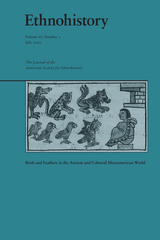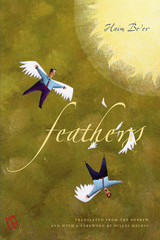2 books about Feathers

Birds and Feathers in the Ancient and Colonial Mesoamerican World
Allison Caplan and Lisa Sousa, special issue editors
Duke University Press
This issue reconstructs the integrated roles of real and symbolic birds and their feathers in ancient and colonial Mesoamerican and trans-Atlantic societies. The contributors—who include biologists, historians, and art historians—combine ethnohistoric methodologies with the physical sciences to analyze pictorial and native-language sources, archival documents, chronicles, feather artworks, and specimens in natural history collections. Contributors explore the semiotics of feathers, highly valued as part of local and imperial economies, in ritual regalia and featherworks. The issue also sheds light on how the shipment of indigenous featherworks and actual birds—both living and stuffed—brought American birds and indigenous knowledge of them into contact with Europe. By foregrounding indigenous knowledge and value systems, the contributors reexamine the significance of birds and feathers in constructions of the natural world, philosophy and religion, society and economics, and artistic practice.
Contributors: Allison Caplan, Martha Few, León García Garagarza, James Maley, John McCormack, Iris Montero Sobrevilla, Lisa Sousa
Contributors: Allison Caplan, Martha Few, León García Garagarza, James Maley, John McCormack, Iris Montero Sobrevilla, Lisa Sousa
[more]

Feathers
Haim Be’er
Brandeis University Press, 2006
When first published in 1979, Haim Be’er’s Feathers was a critical and commercial success, ushering in a period of great productivity and expansiveness in modern Hebrew literature. Now considered a classic in Israeli fiction the book is finally available to English readers worldwide. In this, his first novel, Be’er portrays the world of a deeply religious community in Jerusalem during the author’s childhood and adolescence in the 1950s and 60s. The novel is filled with vivid portraits of eccentric Jerusalem characters, chief among them the book’s main character, Mordecai Leder, who dreams of founding a utopian colony based on the theories of the nineteenth-century Viennese Jewish thinker Karl Popper-Lynkeus. Similar high-flying dreams inspire the family of the narrator, strict Orthodox Jews with impractical minds and adventurous souls—men such as the narrator’s father, who periodically disappears from home on botanical expeditions meant to prove that the willow tree of Scripture is in fact the Australian eucalyptus. Experimental in structure and mood, Feathers features kaleidoscopic jumps in time, back and forth in the narrator’s memories from boyhood to adulthood. Its moods swing wildly from hilarity to the macabre, from familial warmth to the loneliness of adolescence. Jerusalem and its inhabitants, as well as the emotional life of the narrator, are splintered and reconstituted, shattered and patched. This fragmentation, combined with a preoccupation with death and physical dissolution and dreamlike flights of imagination, evokes an Israeli magical realism. Feathers was chosen one of the 100 Greatest Works of Modern Jewish Literature by the National Yiddish Book Center.
[more]
READERS
Browse our collection.
PUBLISHERS
See BiblioVault's publisher services.
STUDENT SERVICES
Files for college accessibility offices.
UChicago Accessibility Resources
home | accessibility | search | about | contact us
BiblioVault ® 2001 - 2024
The University of Chicago Press









